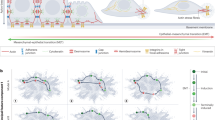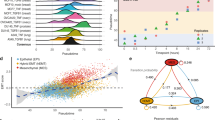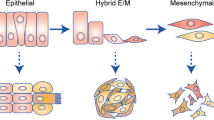Abstract
In contrast to the aberrant control of proliferation, apoptosis, angiogenesis and lifespan, the cellular mechanisms that cause local invasion and metastasis of tumour cells are still poorly understood. New experimental approaches have identified different types of epithelial-plasticity changes in tumour cells towards fibroblastoid phenotypes as crucial events that occur during metastasis, and many molecules and signalling pathways cooperate to trigger these processes.
This is a preview of subscription content, access via your institution
Access options
Subscribe to this journal
Receive 12 print issues and online access
$209.00 per year
only $17.42 per issue
Buy this article
- Purchase on SpringerLink
- Instant access to full article PDF
Prices may be subject to local taxes which are calculated during checkout




Similar content being viewed by others
References
Hunter, T. Oncoprotein networks. Cell 88, 333–346 (1997).
Hanahan, D. & Weinberg, R. A. The hallmarks of cancer. Cell 100, 57–70 (2000).
Elenbaas, B. & Weinberg, R. A. Heterotypic signaling between epithelial tumor cells and fibroblasts in carcinoma formation. Exp. Cell Res. 264, 169–184 (2001).
Thiery, J. P. Epithelial–mesenchymal transitions in tumour progression. Nature Rev. Cancer 2, 442–454 (2002).
Cordon-Cardo, C. & Prives, C. At the crossroads of inflammation and tumorigenesis. J. Exp. Med. 190, 1367–1370 (1999).
Hay, E. D. An overview of epithelio–mesenchymal transition. Acta Anat. 154, 8–20 (1995).
Viebahn, C. Epithelio–mesenchymal transformation during formation of the mesoderm in the mammalian embryo. Acta Anat. 154, 79–97 (1995).
Sun, D., Baur, S. & Hay, E. D. Epithelial–mesenchymal transformation is the mechanism for fusion of the craniofacial primordia involved in morphogenesis of the chicken lip. Dev. Biol. 228, 337–349 (2000).
Martinez-Alvarez, C. et al. Medial edge epithelial cell fate during palatal fusion. Dev. Biol. 220, 343–357 (2000).
Duband, J. L., Monier, F., Delannet, M. & Newgreen, D. Epithelium–mesenchyme transition during neural crest development. Acta Anat. 154, 63–78 (1995).
Knight, D. Epithelium–fibroblast interactions in response to airway inflammation. Immunol. Cell Biol. 79, 160–164 (2001).
Alpers, C. E. et al. Localization of SPARC in developing, mature, and chronically injured human allograft kidneys. Kidney Int. 62, 2073–2086 (2002).
Yang, J. & Liu, Y. Blockage of tubular epithelial to myofibroblast transition by hepatocyte growth factor prevents renal interstitial fibrosis. J. Am. Soc. Nephrol. 13, 96–107 (2002).
Petersen, O. W. et al. Epithelial to mesenchymal transition in human breast cancer can provide a nonmalignant stroma. Am. J. Pathol. 162, 391–402 (2003).
Putz, E. et al. Phenotypic characteristics of cell lines derived from disseminated cancer cells in bone marrow of patients with solid epithelial tumors: establishment of working models for human micrometastases. Cancer Res. 59, 241–248 (1999).
Brabletz, T. et al. Variable β-catenin expression in colorectal cancers indicates tumor progression driven by the tumor environment. Proc. Natl Acad. Sci. USA 98, 10356–10361 (2001).
Oft, M., Heider, K. H. & Beug, H. TGFβ signalling is essential for carcinoma cell invasiveness and metastasis. Curr. Biol. 8, 1243–1252 (1998).
Janda, E. et al. Ras and TGFβ cooperatively regulate epithelial cell plasticity and metastasis: dissection of Ras signaling pathways. J. Cell Biol. 156, 299–313 (2002).
Fialka, I. et al. The estrogen-dependent c-JunER protein causes a reversible loss of mammary epithelial cell polarity involving a destabilization of adherens junctions. J. Cell Biol. 132, 1115–1132 (1996).
Oft, M. et al. TGFβ1 and Ha-Ras collaborate in modulating the phenotypic plasticity and invasiveness of epithelial tumor cells. Genes Dev. 10, 2462–2477 (1996).
Janda, E., Litos, G., Grunert, S., Downward, J. & Beug, H. Oncogenic Ras/Her-2 mediate hyperproliferation of polarized epithelial cells in 3D cultures and rapid tumor growth via the PI3K pathway. Oncogene 21, 5148–5159 (2002).
Lehmann, K. et al. Raf induces TGFβ production while blocking its apoptotic but not invasive responses: a mechanism leading to increased malignancy in epithelial cells. Genes Dev. 14, 2610–2622 (2000).
Gotzmann, J. et al. Hepatocytes convert to a fibroblastoid phenotype through the cooperation of TGF-β1 and Ha-Ras: steps towards invasiveness. J. Cell Sci. 115, 1189–1202 (2002).
Miettinen, P. J., Ebner, R., Lopez, A. R. & Derynck, R. TGF-β induced transdifferentiation of mammary epithelial cells to mesenchymal cells: involvement of type I receptors. J. Cell Biol. 127, 2021–2036 (1994).
Piek, E., Moustakas, A., Kurisaki, A., Heldin, C. H. & ten Dijke, P. TGF-β type I receptor/ALK-5 and Smad proteins mediate epithelial to mesenchymal transdifferentiation in NMuMG breast epithelial cells. J. Cell Sci. 112, 4557–4568 (1999).
Bakin, A. V., Tomlinson, A. K., Bhowmick, N. A., Moses, H. A. & Arteaga, C. L. Phosphatidylinositol 3-kinase function is required for transforming growth factor β-mediated epithelial to mesenchymal transition and cell migration. J. Biol. Chem. 275, 36803–36810 (2000).
Bhowmick, N. A. et al. Transforming growth factor-β1 mediates epithelial to mesenchymal transdifferentiation through a RhoA-dependent mechanism. Mol. Biol. Cell 12, 27–36 (2001).
Sun, D., Vanderburg, C. R., Odierna, G. S. & Hay, E. D. TGFβ3 promotes transformation of chicken palate medial edge epithelium to mesenchyme in vitro. Development 125, 95–105 (1998).
Cui, W. et al. TGFβ1 inhibits the formation of benign skin tumors, but enhances progression to invasive spindle carcinomas in transgenic mice. Cell 86, 531–542 (1996).
Derynck, R., Akhurst, R. J. & Balmain, A. TGF-β signaling in tumor suppression and cancer progression. Nature Genet. 29, 117–129 (2001).
Ten Dijke, P., Goumans, M. J., Itoh, F. & Itoh, S. Regulation of cell proliferation by Smad proteins. J. Cell. Physiol. 191, 1–16 (2002).
Attisano, L. & Wrana, J. L. Signal transduction by the TGF-β superfamily. Science 296, 1646–1647 (2002).
Heldin, C. H. & Westermark, B. Mechanism of action and in vivo role of platelet-derived growth factor. Physiol. Rev. 79, 1283–1316 (1999).
Schulze, A., Lehmann, K., Jefferies, H. B., McMahon, M. & Downward, J. Analysis of the transcriptional program induced by Raf in epithelial cells. Genes Dev. 15, 981–994 (2001).
Beddington, R. S. & Robertson, E. J. Axis development and early asymmetry in mammals. Cell 96, 195–209 (1999).
Ciruna, B. & Rossant, J. FGF signaling regulates mesoderm cell fate specification and morphogenetic movement at the primitive streak. Dev. Cell 1, 37–49 (2001).
Vicovac, L. & Aplin, J. D. Epithelial–mesenchymal transition during trophoblast differentiation. Acta Anat. 156, 202–216 (1996).
Muller, W. J., Sinn, E., Pattengale, P. K., Wallace, R. & Leder, P. Single-step induction of mammary adenocarcinoma in transgenic mice bearing the activated c-neu oncogene. Cell 54, 105–115 (1988).
Muraoka, R. S. et al. Blockade of TGF-β inhibits mammary tumor cell viability, migration, and metastases. J. Clin. Invest. 109, 1551–1559 (2002).
Downward, J. Mechanisms and consequences of activation of protein kinase B/Akt. Curr. Opin. Cell Biol. 10, 262–267 (1998).
Eger, A., Stockinger, A., Schaffhauser, B., Beug, H. & Foisner, R. Epithelial mesenchymal transition by c-Fos estrogen receptor activation involves nuclear translocation of β-catenin and upregulation of β-catenin/lymphoid enhancer binding factor-1 transcriptional activity. J. Cell Biol. 148, 173–188 (2000).
Stockinger, A., Eger, A., Wolf, J., Beug, H. & Foisner, R. E-cadherin regulates cell growth by modulating proliferation-dependent β-catenin transcriptional activity. J. Cell Biol. 154, 1185–1196 (2001).
Labbe, E., Letamendia, A. & Attisano, L. Association of Smads with lymphoid enhancer binding factor 1/T cell-specific factor mediates cooperative signaling by the transforming growth factor-β and wnt pathways. Proc. Natl Acad. Sci. USA 97, 8358–8363 (2000).
Pradet-Balade, B., Boulme, F., Beug, H., Mullner, E. W. & Garcia-Sanz, J. A. Translation control: bridging the gap between genomics and proteomics? Trends Biochem. Sci. 26, 225–229 (2001).
Vecsey-Semjen, B. et al. Novel colon cancer cell lines leading to better understanding of the diversity of respective primary cancers. Oncogene 21, 4646–4662 (2002).
Andrechek, E. R. et al. Amplification of the neu/erbB-2 oncogene in a mouse model of mammary tumorigenesis. Proc. Natl Acad. Sci. USA 97, 3444–3449 (2000).
Webster, M. A. et al. Requirement for both Shc and phosphatidylinositol 3′ kinase signaling pathways in polyomavirus middle T-mediated mammary tumorigenesis. Mol. Cell Biol. 18, 2344–2359 (1998).
Weeks, B. H., He, W., Olson, K. L. & Wang, X. J. Inducible expression of transforming growth factor β1 in papillomas causes rapid metastasis. Cancer Res. 61, 7435–7443 (2001).
Oft, M., Akhurst, R. J. & Balmain, A. Metastasis is driven by sequential elevation of H-ras and Smad2 levels. Nature Cell Biol. 4, 487–494 (2002).
Jacob, S. & Praz, F. DNA mismatch repair defects: role in colorectal carcinogenesis. Biochimie 84, 27–47 (2002).
Takaku, K. et al. Intestinal tumorigenesis in compound mutant mice of both Dpc4 (Smad4) and Apc genes. Cell 92, 645–656 (1998).
McEarchern, J. A. et al. Invasion and metastasis of a mammary tumor involves TGF-β signaling. Int. J. Cancer 91, 76–82 (2001).
Yang, Y. A. et al. Lifetime exposure to a soluble TGF-β antagonist protects mice against metastasis without adverse side effects. J. Clin. Invest. 109, 1607–1615 (2002).
Jechlinger, M. et al. Expression profiling of epithelial plasticity in tumour progression. Oncogene (in the press).
Acknowledgements
The authors would like to thank N. Kraut and R. Foisner for critically reading the manuscript and G. Litos and A. Sommer for expert technical assistance. This work was supported by grants from the Fonds zur Förderung der Wissenschaftlichen Forschung and the Forschunapförderungsfonds der gewerblichen Wirtschaft.
Author information
Authors and Affiliations
Corresponding authors
Supplementary information
Rights and permissions
About this article
Cite this article
Grünert, S., Jechlinger, M. & Beug, H. Diverse cellular and molecular mechanisms contribute to epithelial plasticity and metastasis. Nat Rev Mol Cell Biol 4, 657–665 (2003). https://doi.org/10.1038/nrm1175
Issue Date:
DOI: https://doi.org/10.1038/nrm1175
This article is cited by
-
Ubiquitination-specific protease 7 enhances stemness of hepatocellular carcinoma by stabilizing basic transcription factor 3
Functional & Integrative Genomics (2024)
-
The mechanism of the contribution of ICAM-1 to epithelial–mesenchymal transition (EMT) in bladder cancer
Human Cell (2024)
-
DUSP6 is a memory retention feedback regulator of ERK signaling for cellular resilience of human pluripotent stem cells in response to dissociation
Scientific Reports (2023)
-
Jagged1 intracellular domain/SMAD3 complex transcriptionally regulates TWIST1 to drive glioma invasion
Cell Death & Disease (2023)
-
IC261 inhibits the epithelial-mesenchymal transition induced by TGF-β in A549 lung cancer cells
Applied Biological Chemistry (2022)



